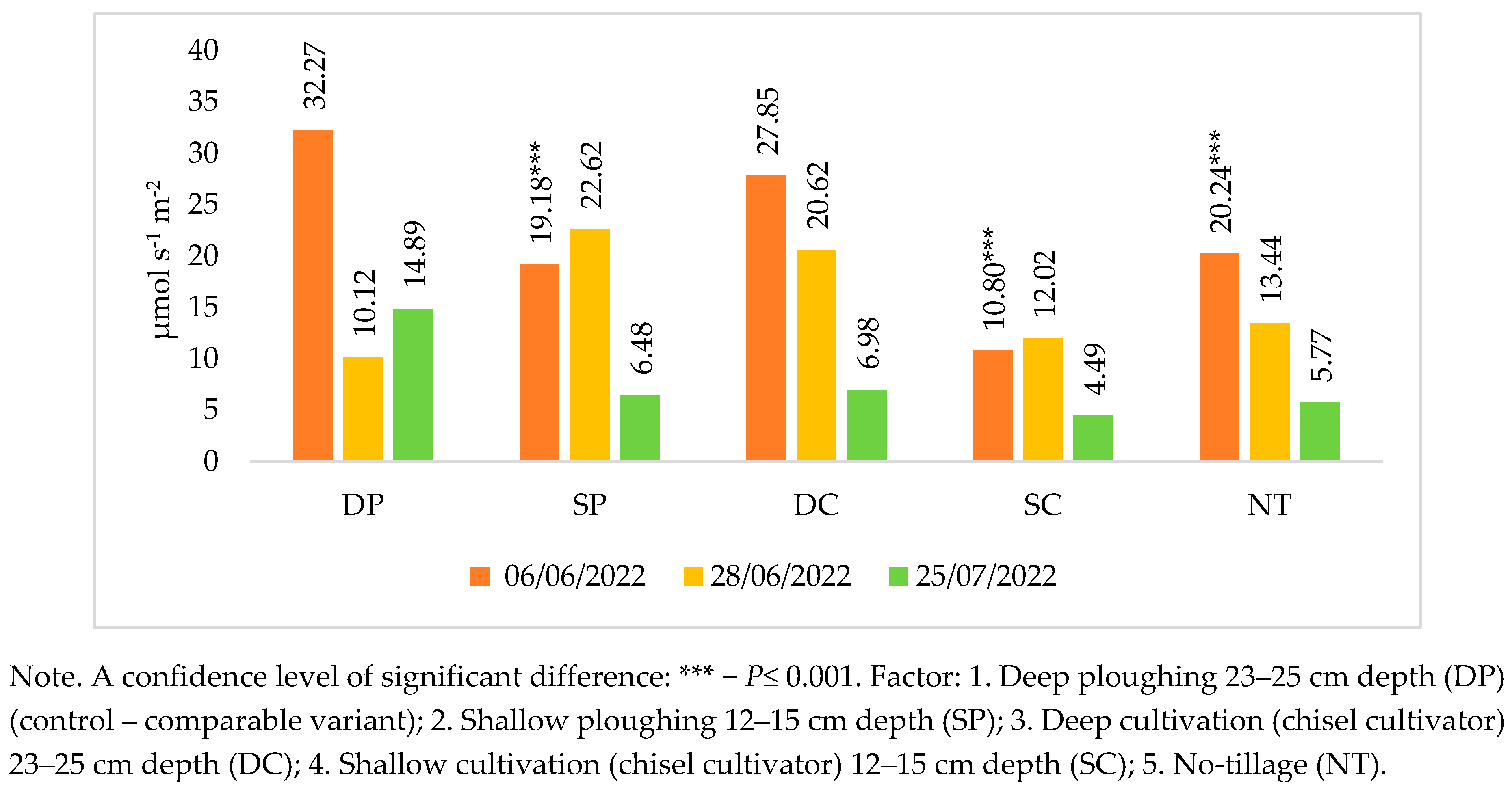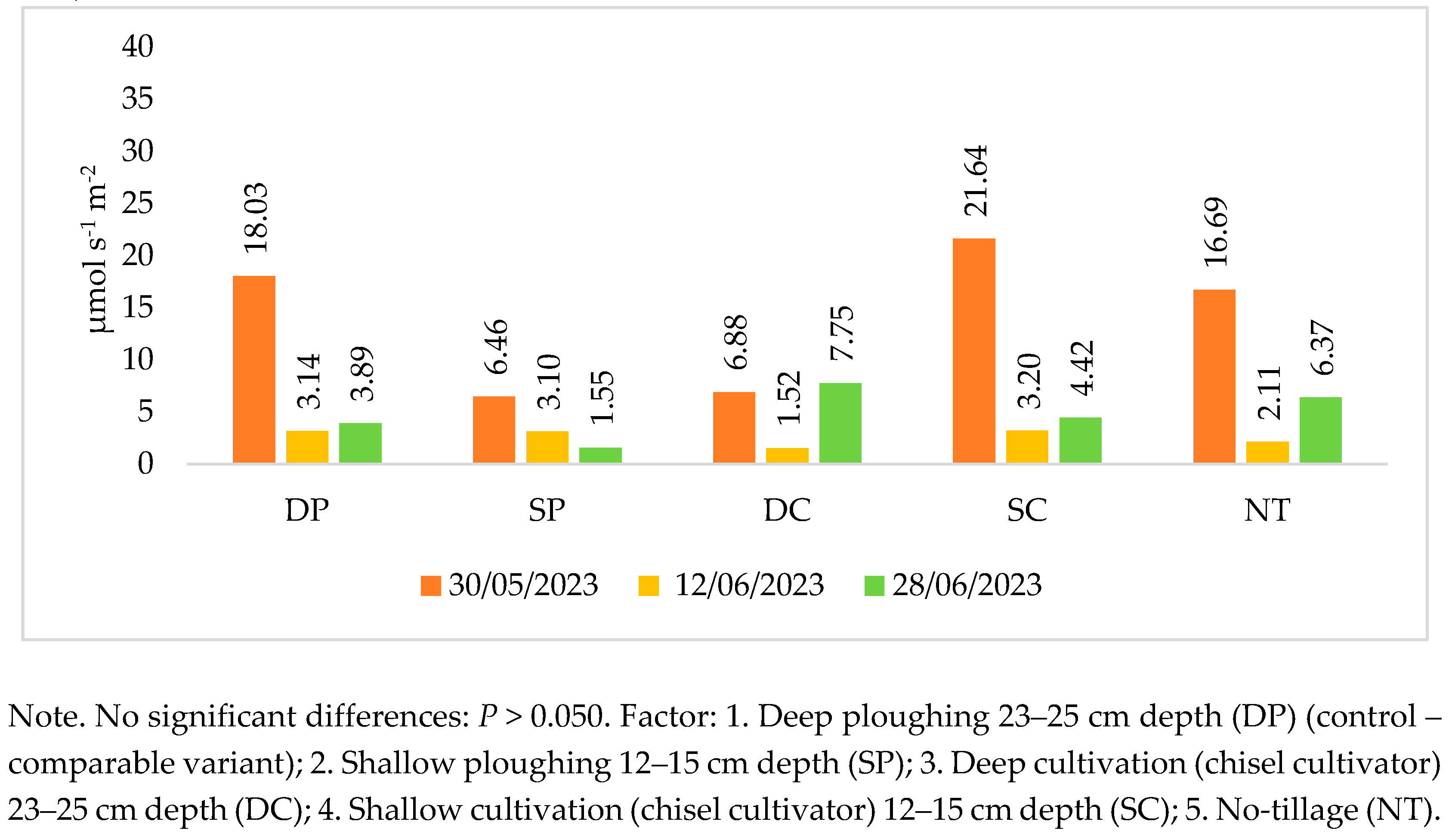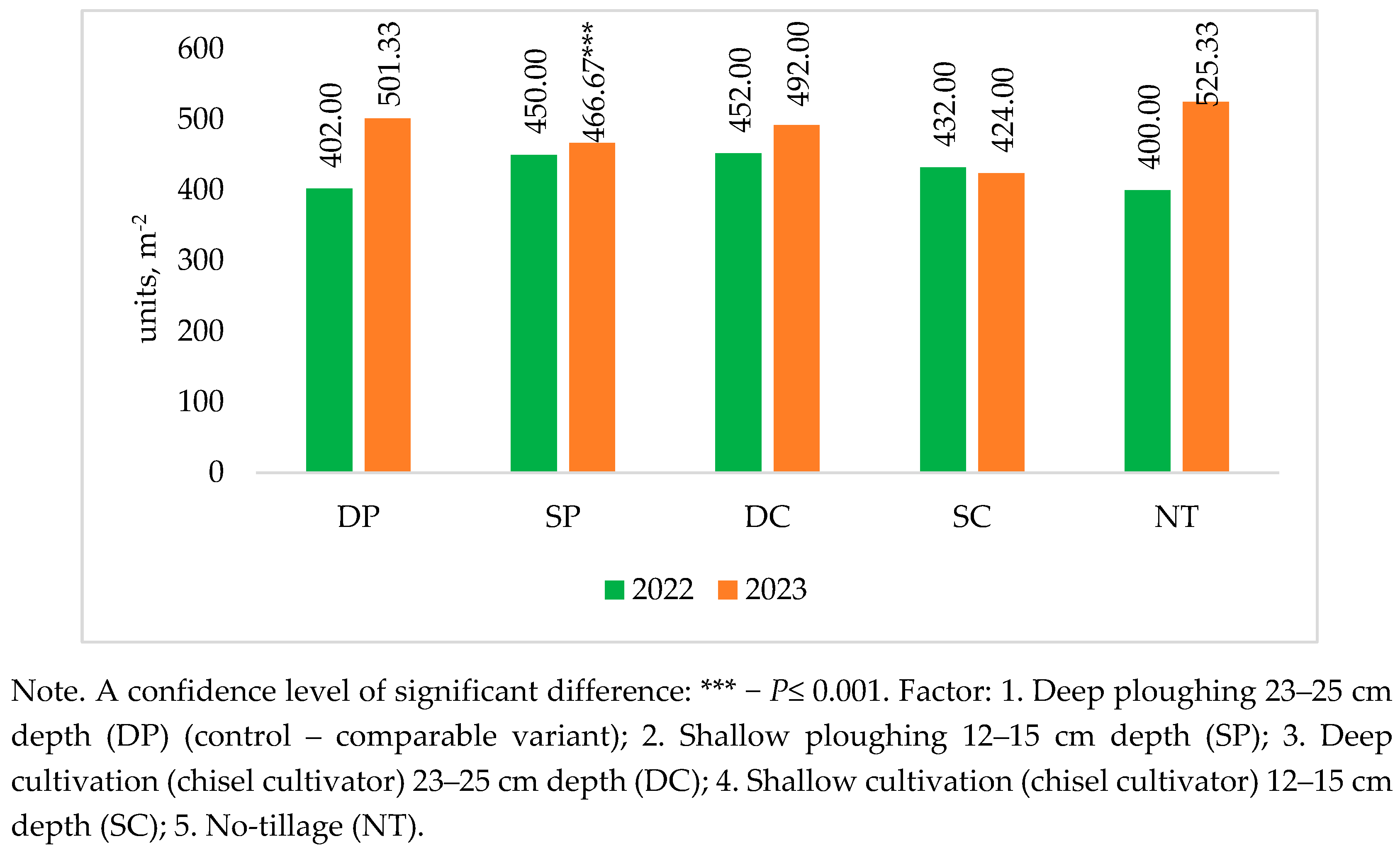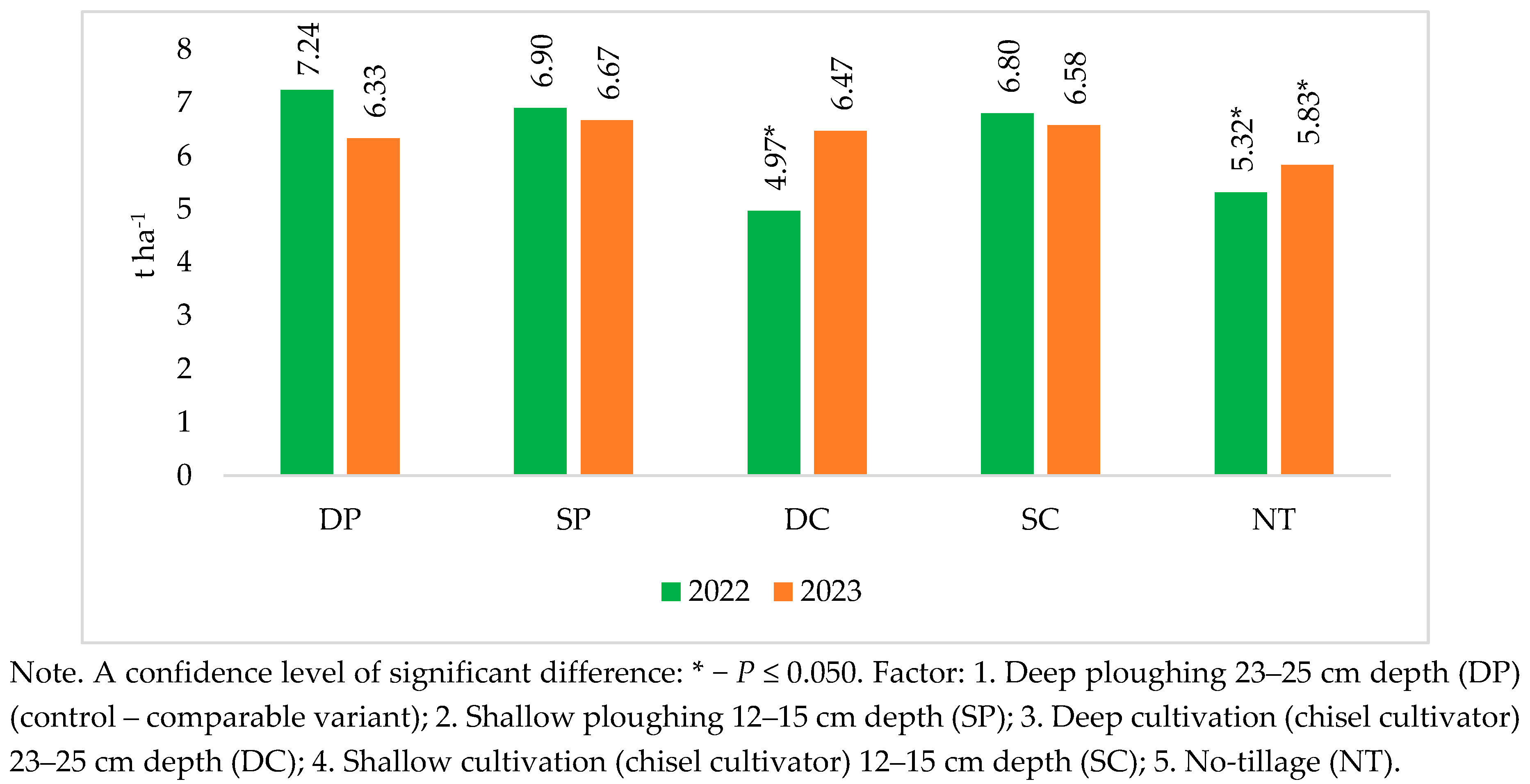Submitted:
12 June 2024
Posted:
13 June 2024
You are already at the latest version
Abstract
Keywords:
1. Introduction
2. Materials and Methods
2.1. Experimental Site
2.2. Experiment Design and Agricultural Practices
Assessment of Crop Density
Statistical Analysis
2.3. Meteorological Conditions
3. Results
3.1. The Effect of Tillage Intensity on Soil Physical Properties
3.2. The Effect of Tillage Intensity on Soil Biological Properties
3.3. The Effect of Tillage Intensity on Spring Barley Productivity Indicators
4. Discussion
5. Conclusions
Author Contributions
Funding
Conflicts of Interest
References
- Feiza, V.; Feizienė, D.; Auškalnis, A.; Kadžienė, G. Sustainable tillage: results from long-term field experiments on Cambisol. Žemdirbystė-Agriculture 2010, 97, 3–14. [Google Scholar]
- Maikštėnienė, S.; Šlepetienė, A.; Masilionytė, L. Verstuvinio ir nevertuvinio pagrindinio žemės dirbimo poveikis glėjiškų rudžemių savybėms ir agrosistemų energetiniam efektyvumui. Žemdirbystė 2007, 94, 3–23. [Google Scholar]
- Jodaugienė, D. The peculiarities of underground and overground parts of Triticum aestivum winter varieties ' Širvinta 1' and 'Zentos' under the conditions of different soil tillage. Žemdirbystė 2002, 77, 59–69. [Google Scholar]
- Buragienė, S.; Šarauskis, E.; Romaneckas, K.; Sasnauskienė, J.; Masilionytė, L.; Kriaučiūnienė, Z. Experimental analysis of CO2 emissions from agricultural soils subjected to five different tillage systems in Lithuania. Sci. Total Environ. 2015, 514, 1–9. [Google Scholar] [CrossRef]
- Steponavičienė, V.; Bogužas, V.; Sinkevičienė, A.; Skinulienė, L.; Vaisvalavičius, R.; Sinkevičius, A. Soil Water Capacity, Pore Size Distribution, and CO2 Emission in Different Soil Tillage Systems and Straw Retention. Plants 2022, 11, 614. [Google Scholar] [CrossRef]
- Avižienytė, D. Romaneckas K., Pališkytė, R., Bogužas, V., Pilipavičius, V., Šarakauskis, E., Adamavičienė, A., Vaiciukevičius, V. The impact of long-term reduced primary soil tillage on maize (<italic>Zea mays</italic> L.) productivity. Agriculture 2023, 100, 377–382. [Google Scholar]
- Veršulienė, A. , Kadžienė, G., Kochiieru, M., Pranaitienė, S., Meškauskienė, L., Auškalnienė, O. Vasarinių miežių šaknų ir dirvožemio fizikinių savybių atsakas į pokyčius po denginiu pasėliu ir skirtingu žemės dirbimu. Žemdirbystė-Agriculture 2022, 4, 291–296. [Google Scholar]
- Galvonaitė, A.; Misiūnienė, M.; Valiukas, D.; Buitkuvienė, M.S. Lietuvos klimatas, 2007; 67–69.
- Cesevičius, G.; Janušauskaitė, D. Dirvožemio mikrobiologinės ir fizikinės savybės įvairiose žemės dirbimo sistemose. Žemdirbystė 2006, 93, 18–34. [Google Scholar]
- Piaulokaitė-Motuzienė, L.; Končius, D. Azotą transformuojančių mikroorganizmų paplitimas esant skirtingoms aplinkos sąlygoms. Žemės ūkio mokslai 2007, 14, 19–26. [Google Scholar]
- Sparovek, G. Earthworm (Pontoscolex corethrurus) and organic matter effects on the reclamation of an eroded Oxisol. Pedobiologic 1999, 43, 698–704. [Google Scholar] [CrossRef]
- Bogužas, V.; Kairytė, A.; Jodaugienė, D. Soil physical properties and earthworms as affected by soil tillage systems, straw and green manure management. Žemdirbystė 2010, 97, 3–14. [Google Scholar]
- Juchnevičienė, A.; Raudonius, S.; Avižienytė, D.; Romaneckas, K.; Bogužas, V. Ilgalaikio supaprastinto žemės dirbimo ir tiesioginės sėjos įtaka žieminių kviečių pasėliui. Žemės ūkio mokslai 2012, 19, 139–150. [Google Scholar] [CrossRef]
- Roscoe, R.; Furtini-Neto, A.E.; Guedes, G.A.A.; Fernandes, L.A. Urease activity and it is relation to soil organic matter, mikcrobia biomass nitrogen and urea−nitrogen assimilation by maize in a Brazilan Oxisoil under no-tillage and tillage systems. Biology and fertility of soil 2000, 32, 52–59. [Google Scholar] [CrossRef]
- Zhang, P. Effects of straw incorporation on the soil nutrient contents, enzyme activities, and crop yield in a semiarid region of China. Soil and Tillage Research 2016, 160, 65–72. [Google Scholar] [CrossRef]
- Zhang, Y.; Li, J. The effects of rotating conservation tillage with conventional tillage on soil properties and grain yields in winter wheat−spring maize rotations. Agricultural and Forest Meteorology 2018, 263, 107–117. [Google Scholar] [CrossRef]
- Toth, M.; Stumpp, Ch.; Klik, A.; Strauss, P.; Shulz, B.; Liebhard, G.; Strohmeier, S. Long-term effects of tillage systems on soil health of a silt loam in Lower Austria. Soil Tillage Res. 2024, 241, 106120. [Google Scholar] [CrossRef]
- Kumari, P.; Singh, J.; Kumar, P. Impact of bioenergy for the diminution of an ascending global variability and change in the climate. In Microbiome Under Changing Climate. Elsevier 2022, 21, 469–487. [Google Scholar]
- Pribyl, D.W. A critical review of the conventional SOC to SOM conversion factor. Geoderma 2010, 156, 75–83. [Google Scholar] [CrossRef]
- Krauss, M.; Wiesmeier, M.; Don, A.; Cuperus, F.; Gattinger, A.; Gruber, S.; Haagsma, W.K.; Peigné, J.; Chiodelli-Palazzoli, M.; Schulz, F.; Heijden, M.G.A.; Vincent-Caboud, L.; Wittwer, R.A.; Zikeli, S.; Steffens, M. Reduced tillage in organic farming affects soil organic carbon stocks in temperate Europe. Soil Tillage Res. 2022, 216, 105262. [Google Scholar] [CrossRef]
- Datt, N.; Singh, D. Enzymes in relation to soil biological properties and sustainability. Biomedical and Life Sciences 2019, 383–406. [Google Scholar]
- Samuel, A. D.; Domuta, C.; Ciobanu, C.; Sandor, M. Field management effects on soil enzyme activities. Romanian agricultural research 2008, 28, 61–68. [Google Scholar]
- Nath, C.P.; Kumar, N.; Das, K.; Hazra, K.K.; Praharaj, C.S.; Singh, N.P. Impact of variable tillage-based residue management and legume-based cropping for seven years on enzymes activity, soil quality index and crop productivity in rice ecology. Environmental and Sustainability Indicators 2021, 10, 1–11. [Google Scholar] [CrossRef]
- Trap, J.; Riah, W.; Akpa−Vinceslas, M.; Bailleul, C.; Laval, K.; Trinsoutrot−Gattin, I. Improved effectiveness and efficiency in measuring soil enzymes as universal soil quality indicators using microplate fluorimetry. Soil Biology and Biochemistry 2012, 45, 98–101. [Google Scholar] [CrossRef]
- Rao, Ch.S.; Grover, M.; Kundu, S.; Desai, S. Soil Enzymes. In Encyclopedia of Soil Science. Taylor and Francis 2017, 2100–2107. [Google Scholar]
- Brussaard, L.; De Ruiter, P.C.; Brown, G. Soil biodiversity for agricultural sustainability. Agriculture, ecosystems environment 2007, 121, 233–244. [Google Scholar] [CrossRef]
- Kibblewhite, M.G. , Ritz, K., Swift, M. J. Soil health in agricultural systems. Philosophical Transactions of the Royal Society B. Biological Sciences 2008, 363, 685–701. [Google Scholar] [CrossRef]
- Bastida, F.; Zsolnay, A.; Hernández, T.; García, C. Past, present and future of soil quality indices: a biological perspective. Geoderma 2008, 147, 159–171. [Google Scholar] [CrossRef]
- Hicks Pries, C.E.; Castanha, C.; Porras, R.C.; Torn, M.S. The whole−soil carbon flux in response to warming. Science 2017, 355, 1420–1423. [Google Scholar] [CrossRef]
- Badagliacca, G.; Benítez, E.; Amato, G.; Badalucco, L.; Giambalvo, D.; Laudicina, V.A.; Ruisi, P. Long-term no-tillage application increases soil organic carbon, nitrous oxide emissions and faba bean (<italic>Vicia faba </italic>L.) yields under rain-fed Mediterranean conditions. Science of the Total Environment. 2018, 639, 350–359. [Google Scholar]
- SPSS. Instat 10. Statistics I. Chicago. 200, 663.
- Raudonius, S. Statistikos taikymas augalų ir pasėlių tyrimuose: svarbūs klausimai. Žemdirbystė-Agriculture 2017, 104, 377–382. [Google Scholar]
- Juhola, S. , Klein, N., Käyhkö, J., Neset, Climate change transformations in Nordic agriculture? Journal of Rural Studies 2017, 51, 28–36. [Google Scholar] [CrossRef]
- Dirsė, A.; Taparauskienė, L. Drėgmingumo kaita augalų vegetacijos metu ir jo vertinimo metodų palyginimas. Žemės ūkio mokslai 2010, 17, 9–17. [Google Scholar]
- Feizienė, D. , Feiza, V., Vaidelienė, A., Povilaitis, V., Antanaitis, Š. Soil surface carbon dioxide exchange rate as affected by soil texture, different long-term tillage application and weather. Žemdirbystė-Agriculture 2010, 97, 25–42. [Google Scholar]
- Buragienė, S. Skirtingų žemės dirbimo technologijų poveikis aplinkai: daktaro disertacija. 2013, Kaunas.
- Sinkevičius, A. Žemės dirbimo technologijų ilgalaikis poveikis agroekosistemų tvarumui: daktaro disertacija. 2023, Akademija, Kauno r.
- Andruškaitė, I. Dirvožemio tvarumas didinant anglies sankaupų sluoksniavimąsi armenyje skirtingo žemės dirbimo sąlygomis. 2022, Akademija, Kauno r.
- Dencso, M.; Toth, E.; Zsigmond, T.; Saliga, R.; Horel, A. Grass cover and shallow tillage inter-row soil cultivation affecting CO2 and N2O emissions in a sloping vineyard in upland Balaton, Hungary. Geoderma Reg. 2024, 37, 792–802. [Google Scholar] [CrossRef]
- Liu, Y.; Li, Q.; Wang, Q.; Zhang, Q.; Yang, Z.; Li, G. Arbuscular mycorrhizal fungi affect the response of soil CO2 emission to summer precipitation pulse following drought in rooted soils. Agric. For. Meteorol. 2024, 352, 110023. [Google Scholar] [CrossRef]
- Steponavičienė, V.; Žiūraitis, G.; Rudinskienė, A.; Jackevičienė, K.; Bogužas, V. Long-Term Effects of Different Tillage Systems and Their Impact on Soil Properties and Crop Yields. Agronomy 2024, 14, 870. [Google Scholar] [CrossRef]
- Du, K.; Li, F.; Qiao, Y.; Leng, P.; Zhao, L.; Ge, J.; Yang, G. Influence of no-tillage and precipitation pulse on continuous soil respiration of summer maize affected by soil water in the North China Plain. Sci. Total Environ. 2021, 766, 144384. [Google Scholar] [CrossRef]
- Gelybo, G.; Barcza, Z.; Dencso, M.; Potyo, I.; Kasa, I.; Horel, A.; Pokovai, K.; Birkas, M.; Kern, A.; Hollos, R.; Toth, E. Effect of tillage and crop type on soil respiration in a long-term field experiment on chernozem soil under temperate climate. Soil Tillage Res. 2022, 216, 105239. [Google Scholar] [CrossRef]
- Lu, X.; Lu, X.; Liao, Y. Dirvožemio CO2 emisija ir jos ryšys su dirvožemio savybėmis skirtingose žemės dirbimo sistemose. Archives of Agronomy and Soil Science 2015, 62, 1021–1032. [Google Scholar] [CrossRef]
- Bogužas, V.; Sinkevičienė, A.; Romaneckas, K.; Steponavičienė, V.; Skinulienė, L.; Butkevičienė, L.M. The impact of tillage intensity and meteorological conditions on soil temperature, moisture content and CO2 efflux in maize and spring barley cultivation. Žemdirbystė 2018, 105, 307–314. [Google Scholar]
- Niether, W.; Macholdt, J.; Schulz, F.; Gattinger, A. Yield dynamics of crop rotations respond to farming type and tillage intensity in an organic agricultural long-term experiment over 24 years. Field Crops Res. 2023, 303, 109131. [Google Scholar] [CrossRef]




| Tillage system | Stubble tillage | Primary tillage | Implement | Depth of tillage (cm) |
| Deep ploughing | Yes | Inversion | Mouldboard plough | 22–25 |
| Shallow ploughing | Yes | Inversion | Mouldboard plough | 12–15 |
| Deep cultivation | Yes | Non-inversion | Chisel cultivator | 25–30 |
| Shallow cultivation | Yes, twice | No | Chisel cultivator | 10–12 |
| No-tillage | No | No | None | 0 |
| Year/ Month | May | June | July | August |
| 2022 | 11.0 | 17.7 | 18.0 | 20.8 |
| 2023 | 12.6 | 17.3 | 17.9 | 20.2 |
| Long-term (1974–2023) average | 13.2 | 16.1 | 18.7 | 17.3 |
| Year/Month | May | June | July | August |
| 2022 | 84.0 | 77.6 | 100.5 | 38.7 |
| 2023 | 14.3 | 64.0 | 36.8 | 96.2 |
| Long-term (1974–2023) average | 61.7 | 76.9 | 96.6 | 88.9 |
| Measurement data | Tillage systems | ||||
|---|---|---|---|---|---|
| Deep ploughing (DP) |
Shallow ploughing (SP) |
Deep cultivation (DC) |
Shallow cultivation (SC) |
No-tillage (NT) |
|
| 2022 | |||||
| 06/06/2022 28/06/2022 |
22.98 | 25.59* | 23.04 | 25.44* | 23.39 |
| 29.98 | 31.15 | 29.20 | 29.14 | 30.54 | |
| 25/07/2022 | 24.57 | 25.06 | 22.26 | 21.38* | 23.68 |
| 12/08/2022 | 25.42 | 26.06 | 26.19 | 28.24 | 22.99 |
| 2023 | |||||
| 23/05/2023 | 11.68 | 12.97 | 14.26 | 15.01 | 18.41 |
| 30/05/2023 | 10.66 | 10.28 | 10.64 | 10.73 | 10.33 |
| 12/06/2023 | 8.78 | 9.78 | 8.62 | 8.58 | 8.95 |
| 28/06/2023 | 21.94 | 13.87 | 20.65 | 20.91 | 21.46 |
| 04/08/2023 | – | – | – | – | – |
| Measurement data | Tillage systems | ||||
|---|---|---|---|---|---|
| Deep ploughing (DP) |
Shallow ploughing (SP) |
Deep cultivation (DC) |
Shallow cultivation (SC) |
No-tillage (NT) |
|
| 2022 | |||||
| 06/06/2022 | 21.71 | 19.62*** | 0.00*** | 0.62** | 20.69* |
| 28/06/2022 | 25.81 | 27.07 | 25.15 | 25.50 | 27.26 |
| 25/07/2022 | 24.06 | 22.89 | 22.73* | 22.76* | 21.64** |
| 12/08/2022 | 24.53 | 24.18 | 25.10 | 25.47 | 24.34 |
| 2023 | |||||
| 23/05/2023 | 26.93 | 27.67 | 26.71 | 26.54 | 27.07 |
| 30/05/2023 | 20.92 | 20.95 | 20.95 | 21.17 | 21.05 |
| 12/06/2023 | 22.65 | 23.76 | 23.78 | 23.04 | 23.84 |
| 28/06/2023 | 23.27 | 14.70 | 22.31 | 21.84 | 21.40 |
| 04/08/2023 | 29.35 | 29.55 | 29.57 | 29.50 | 30.80 |
| Measurement data | Tillage systems |
||||||||||||
|---|---|---|---|---|---|---|---|---|---|---|---|---|---|
| Deep ploughing (DP) |
Shallow ploughing (SP) |
Deep cultivation (DC) |
Shallow cultivation (SC) |
No-tillage (NT) |
|||||||||
| 0-10 cm | 10-20 cm |
0–10 cm |
10-20 cm |
0-10 cm |
10-20 cm |
0–10 cm |
10-20 cm |
0-10 cm |
10-20 cm |
||||
| 2022 | |||||||||||||
| 07/06/2022 26/07/2022 12/08/2022 |
0.068 | 0.247 | 0.067 | 0.086 | 0.069 | 0.242 | 0.064 | 0.236 | 0.142 | 0.107 | |||
| 0.136 | 0.164 | 0.289 | 0.330 | 0.313 | 0.220 | 0.159 | 0.168 | 0.168 | 0.129 | ||||
| 0.105 | 0.333 | 0.585 | 0.740 | 0.290 | 0.345 | 0.090 | 0.078 | 0.165 | 0.123 | ||||
| 2023 | |||||||||||||
| 23/05/2023 28/06/2023 |
0.890 | 0.330 | 0.467 | 0.223 | 0.180** | 0.170 | 0.493 | 0.278 | 0.225** | 0.175 | |||
| 0.652 | 0.652 | 0.642 | 0.645 | 0.637 | 0.638 | 0.633* | 0.640 | 0.400 | 0.642 | ||||
| 04/08/2023 | 0.000 | 0.208 | 0.000 | 0.050* | 0.000 | 0.058* | 0.000 | 0.068* | 0.000 | 0.060* | |||
Disclaimer/Publisher’s Note: The statements, opinions and data contained in all publications are solely those of the individual author(s) and contributor(s) and not of MDPI and/or the editor(s). MDPI and/or the editor(s) disclaim responsibility for any injury to people or property resulting from any ideas, methods, instructions or products referred to in the content. |
© 2024 by the authors. Licensee MDPI, Basel, Switzerland. This article is an open access article distributed under the terms and conditions of the Creative Commons Attribution (CC BY) license (http://creativecommons.org/licenses/by/4.0/).





